The Supermicro X11SBA-LN4F review is one that was highly requested by the STH community. For those looking at software defined networking and other low power applications, the appeal of a low (6w) TDP chip with four Gigabit Ethernet NICs attached is obvious. On board the Supermicro X11SBA-LN4F is an Intel Pentium N3700 which we benchmarked recently. Today we have a review of the entire low power platform which is sure to have those building network appliances very excited.
Test Configuration
For this review we are reporting numbers from the Supermciro X11SBA-LN4F platform that we will have a formal review on shortly. Here is the spec of what we are using:
- Platform: Supermicro X11SBA-LN4F with onboard Intel Pentium N3700
- RAM: 8GB DDR3L 1600MHz (1.35v) in 2x Crucial 4GB SODIMMs
- Storage: Supermicro SuperDOM SATADOM (64GB), Intel DC S3610 800GB, Samsung 845DC EVO 480GB (swapped for different tests)
- Chassis and PSU: Supermicro SC505-203B
- OSes: Ubuntu 14.04.3, 15.10, pfSense 2.2.4, 2.2.6
One word here on the configuration. We ended up using a Supermicro SC505-203B chassis and its included power supply. This platform did not post with our PicoPSU 160XT that we would normally use and our Seasonic 650w 80Plus Gold power supply did not have enough load to even turn the board on. Time did not permit us to test more than these three configurations so we used the one that worked flawlessly. Our recommendation is to stick with lower power Supermicro power supplies if possible.
Supermicro X11SBA-LN4F Overview
The Supermicro X11SBA-LN4F is a mITX form factor motherboard meaning it will fit in just about any server chassis. Full specs can be found here however we are going to cover the basics. One can see that space is limited in the platform to the point that DDR3 SODIMMs must be used. Our test configuration utilized the Pentium N3700’s 8GB max with two 4GB low voltage SODIMMs. We did try using two 8GB DIMMs to test the 8GB limit but the board did not boot with that configuration.
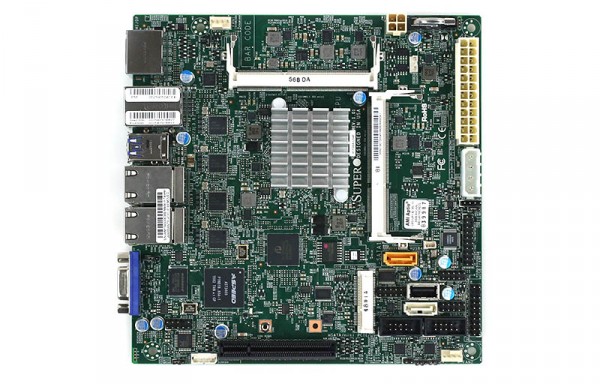
One can see the onboard Intel Pentium N3700 SoC that has 4 cores/ 4 threads and is rated at 6w TDP. We did have airflow over our unit while testing, but the heatsink seems to be able to keep the SoC cool in passive environments. Slightly shocking to us is that Intel’s suggested pricing for this SoC is currently $161 which is about on par with a Core i3-6320. The advantage of the Pentium N3700 is that it is a low power part, but it is a big driver in the cost of this platform.

There is one PCIe slot which is a PCIe 2.0 x1 electrical connection in a x8 physical slot. There is also a mPCIe slot that supports mSATA SSDs.
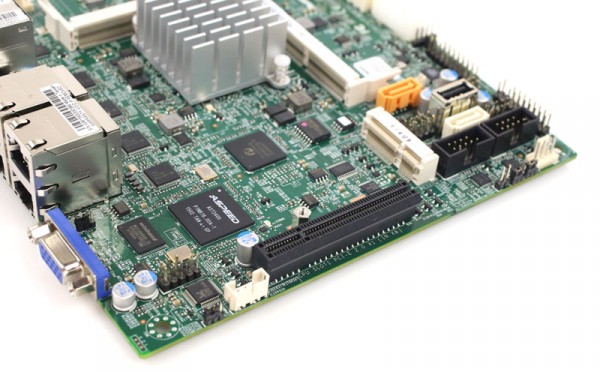
Providing management functionality we can see an Aspeed AST2400 chip onboard. This is the IPMI controller. There are other products on the market with the Pentium N3700, including the Intel NUC but having remote management capabilities through standard IPMI is a clear differentiator for this platform.
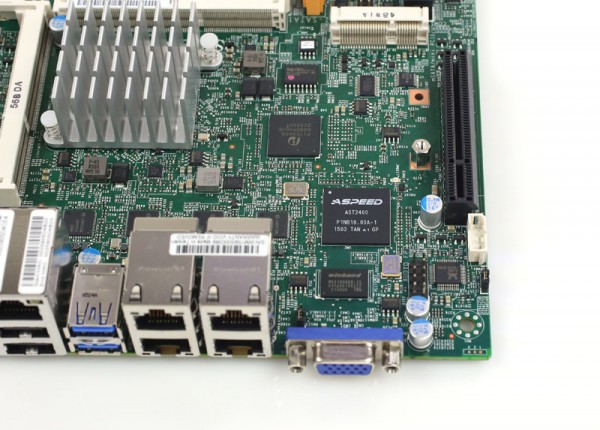
The Pentium N3700 has limited storage capabilities, but the Supermicro X11SBA-LN4F makes the most of them. Aside from the aforementioned mPCIe slot, there are two SATA III 6.0gbps ports. The orange/ yellow port can be used with a Supermicro SuperDOM but one is limited to two SATA devices. Supermciro does include a USB 2.0 Type-A header next to two COM port headers. One can use this internal USB port to boot from a USB device which is popular in embedded applications.

Perhaps the most intriguing feature of this motherboard are the quad NICs in addition to the IPMI management NIC. We can see the four Intel i210-AT controllers onboard. These are certainly premium Gigabit Ethernet controllers compared to Realtek NICs in consumer applications. They cost more than three times what a Realtek Gigabit NIC does. The Intel i210-AT is extremely popular and should work out-of-the-box with just about any OS. Later in this review, we verified it works well with pfSense, a popular FreeBSD based firewall package as a corner case for compatibility.
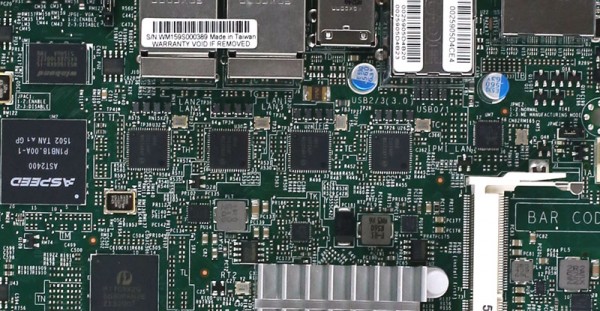
Moving to the rear I/O panel we can see a solid selection of onboard ports. There are five network ports, one for IPMI the others for data that we have already covered. In addition, we find two USB 2.0 and two USB 3.0 ports onboard.

The video output is interesting as we see a standard legacy VGA port which is hooked up to the BMC (AST2400). We also see two digital video ports a HDMI and Display Port port. These two digital outputs work with the Pentium N3700 SoC graphics. Overall this is a very complete package.
Performance
One can see an example run of Linux-Bench here and our full X11SBA-LN4F/ Pentium N3700 performance benchmarks here. We did want to give a quick summary of that piece.
First we looked at the performance of our server platform with chassis fans cooling, and found it actually performed better than the Intel NUC with the same CPU. C-ray is a ray tracing benchmark which is great for testing multi-core CPUs. One can see the same chip performed better in our X11SBA-LN4F test bed.
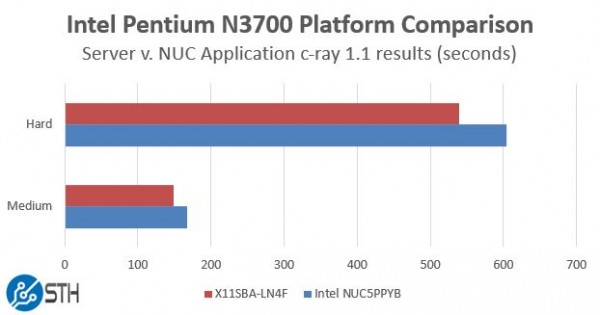
We also wanted to take a second to provide one of the OpenSSL results from that article just to show some relative performance ratings.
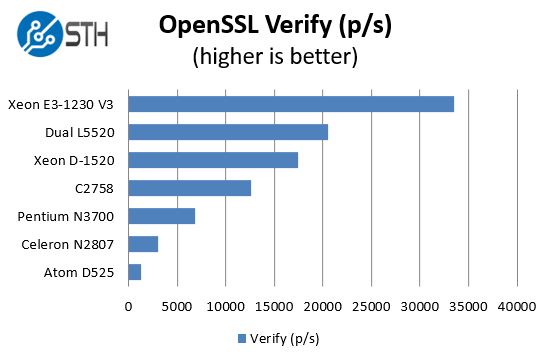
While not as fast as some larger, more power hungry server processors, for those still using the Intel Atom D525 and similar older generation platforms for network appliances, not only does one see lower power consumption with this new platform, but one also can see a very large performance increase. With AES-NI, the Pentium N3700 can deliver much better performance. Unlike the Rangely and new Xeon D parts, the Pentium N3700 does not have Quick Assist so if you have higher end software that needs QA acceleration, that may be a reason to jump to higher performing parts.
As one will see with our Server Boot Time use case video below, with the Supermicro X11SBA-LN4F, no longer does ultra low power mean excruciatingly slow performance.
Use Case: Server Boot Time
Since these small network appliances often run low power but critical applications such as firewalls or networked displays, we do not like to see excessive boot times as we did with the Intel Atom D525 series of previous-generation low power processors. We did a very simple test installing Ubuntu 15.10 server onto the system and letting it boot. This is the full OS installation with a few packages such as openssh-server installed.
As one can see, the full boot time from completely off to the Ubuntu login prompt is under 1 minute which is very good. There are certainly BIOS settings we could disable to get this even lower such as network boot ROMs for PXE booting and provisioning, but out-of-the-box one can get sub-1 minute boot times.
Application Check: Running pfSense
pfSense is perhaps one of the most popular network appliance applications today. Aside from being a natural application fit for the X11SBA-LN4F, It is also FreeBSD based meaning it is a bit more sensitive to hardware. We used pfSense 2.2.4 just to see if the OS would install or if it would cause issues.
As one can see, pfSense booted immediately for us and without issue. This was great to see as it makes for a simplified installation.
Power and Thermal Imaging
To capture these images we utilize our FLIR Ex series professional thermal imaging camera and turn on FLIR’s MSX enhancements so we can see components outlined clearly. We put the system under 100% CPU load for a period of 24 hours to let “heat soak” set in prior to taking the images. We also set the FLIR software to 22C min and 60C maximum so that it can be compared with other images on this site.
One can see that the Aspeed AST2400 is by far the hottest chip whereas the SoC heatsink is relatively cool. One can also see heat signatures from other ICs like the Intel i210-AT controllers. Overall though, this is one of the coolest running platforms we have ever tested.
We used our Extech TrueRMS Power Analyzer 380803 to take measurements at different points of the board’s use.
- Power off (BMC only) power consumption: 4.1w
- Idle power consumption: 11.6w
- Maximum observed power consumption: 21.7w
We were using a power supply that was significantly too large for the build (200w) while Supermicro sells this motherboard in the SYS-E200-9B with a 60w PSU. We likely could have improved on our power consumption figures with a smaller PSU as we barely able to breach 10% load on the power supply, well below what is needed for maximum efficiency.
Our big takeaway here is that this platform is awesome on power. The Pentium N3700 may have a very low TDP but there are other ICs, SSDs RAM modules, network controllers and etc. that make up a majority of the power consumption of the platform.
Supermicro IPMI and Remote Management
Supermicro’s IPMI and KVM-over-IP as described a few times on this site, allows for a lot of deployment flexibility. Things such as fan speeds, chassis intrusion sensors, thermal sensors, and etc. can be monitored remotely. Alerts can be setup to notify the admins of issues. Beyond this, the functionality also allows for remote power control. One can do remote power up, power down, and reset of the server in the event that it becomes unresponsive.
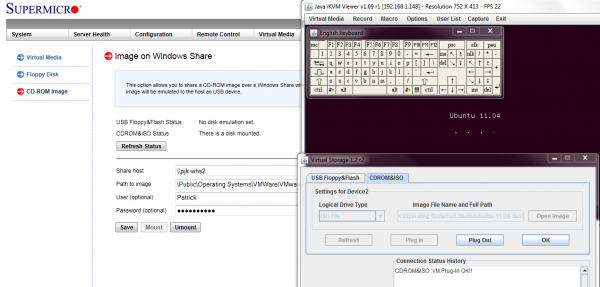
Another important feature is the ability to remotely mount CD images and floppy images to the machine over the dedicated management Ethernet controller. This keeps maintenance traffic off of the primary Intel NICs. At the same time it removes the need for an optical disk to be connected to the Supermicro motherboard.
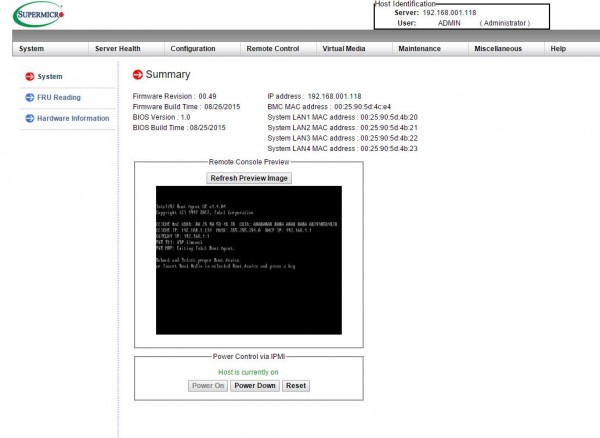
The latest revision of Supermicro’s BIOS has a great feature: the BMC IP address shows up on the post screen! This is a super feature because if one has a KVM cart hooked up to the system, it gives an indicator of which machine one is connected to during post.
Supermicro does include KVM-over-IP functionality with the motherboard. We have been testing servers from HP, Dell, Lenovo and Intel that all required an additional add-in key to get this functionality. It is an absolute time and money saver in the datacenter and other vendors should follow Supermicro’s lead in this space.
Conclusion
With a street price of under $220 the pricing is fairly reasonable. Much of that price is dictated by the fact that (in our opinion) Intel’s Pentium N3700 pricing is too high which then trickles down to the motherboard manufacturer. If you are building a pfSense or similar network appliance, and do not need Quick Assist, this platform should be given significant consideration. it is lower power than the Intel Atom C2558/ C2758 and with a slightly lower cost. In addition, one does get the GPU capabilities with digital video and audio out so there are a number of use cases where this may serve other purposes. For us the impact is clear – this Braswell platform is the end of the line older Atom D510, D525, S1260 generations as it simply does everything better and at a lower cost than the C2558 based platforms.

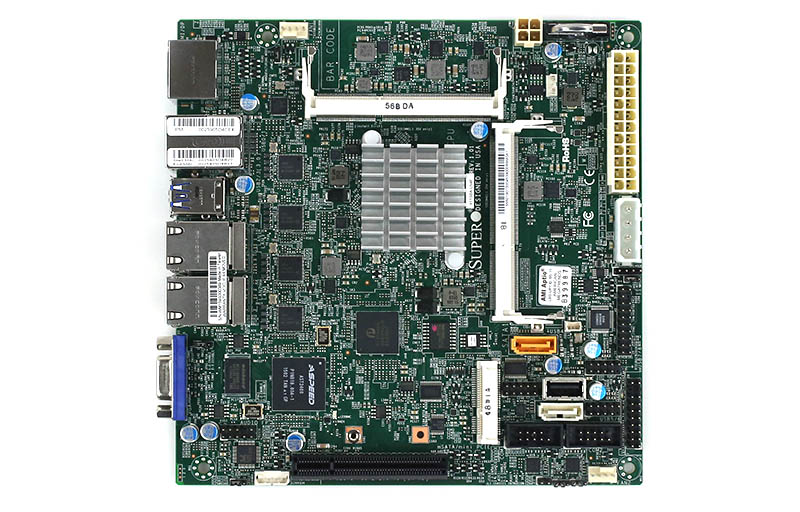
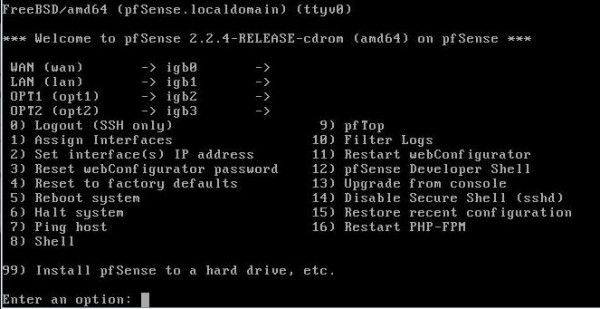
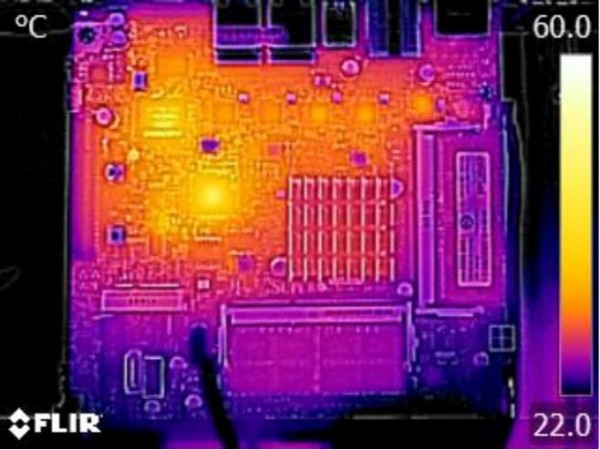
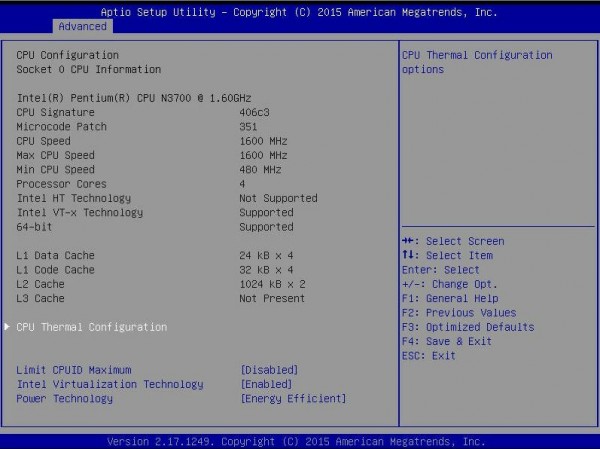



Great article – it’s worth noting that ASROCK N3700 motherboards (with processor) are available new on eBay and Amazon for under $130 so the volume pricing on the N3700 must be a lot lower than the street price.
I am thinking about building a Vyos firewall/VPN gateway. We have 1Gbs dedicated BGB internet connection at our collocation facility. This would be used in a production environment for an eCommerce site. Do you think this device would have enough horsepower to work as as a firewall and as a robust VPN for 2 or 3 users?
Thanks,
-Mike
I believe there is a forum post about another Supermicro variant of this board on the pfSense forums stating that the user was getting A LOT of timeouts requiring a full reboot. I would tread carefully still on this until that sort of thing gets sorted out.
Zach – I actually have this board in the Sunnyvale, CA colo and have not seen any issues for the past 10 days even with a VPN link active at around 40mbps. Do you know which variant it is?
Patrick,
A user on the pfSense forums is actually using this exact model. Here’s the link: https://forum.pfsense.org/index.php?topic=98230.0. There’s a good amount of information, but according to user Engineer on that post, it sounds like Supermicro may have made a revision to the board to address the issue. The forum post is a good read, with the exception of the spat between one of the pfSense admins and Engineer in pages 4-6.
I was looking at this platform to replace my Supermicro A1SRI-2758F that I currently have in the pfSense role, so I could delegate that board to being another virtualization host.
I am very satisfied with this a bit expensive Supermicro SYS-E200-9B as home server and private cloud. For those interested do not hasitate to install Proxmox VE 4.x. I am able to achieve network throughput up to 80/40 MB/s with VyOS installed (full KVM). Average power consumption is 15 W.